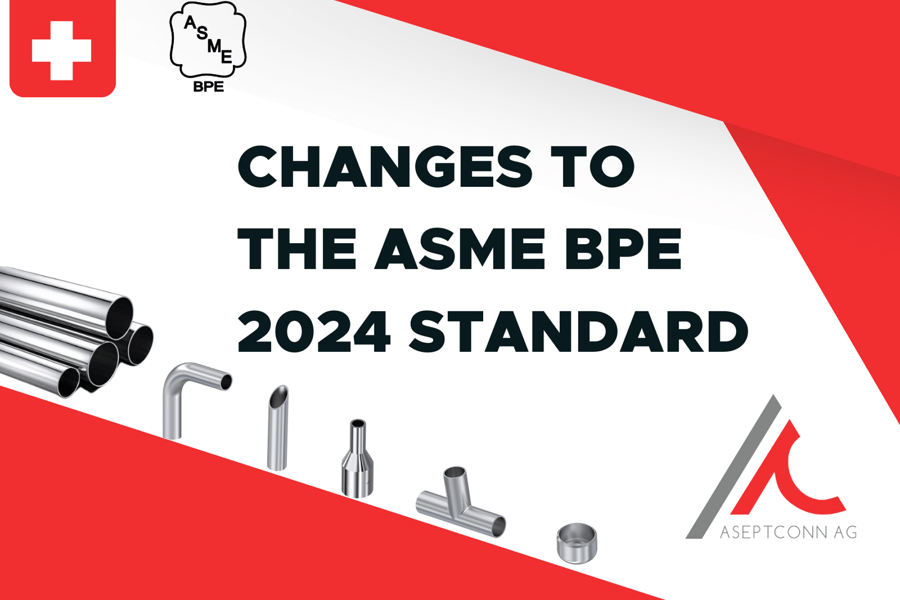Introduction to the ASME BPE standard
Context and importance
The ASME BPE standard (Bioprocessing Equipment, developed by the American Society of Mechanical Engineers) is an essential set of regulations for the pharmaceutical, biotechnological, chemical, cosmetics and food industries. It defines strict requirements for the design and manufacturing of liquid processing equipment, focusing on purity, safety and compliance with quality standards. By applying this standard, companies ensure consumer safety and strengthen their reliability - critical values in industries where every detail can impact quality.
Purity and safety requirements
In critical industries, even the slightest contamination can turn a product into a potential hazard. The ASME BPE standard sets stringent requirements for materials, welds, surface finishes and fittings to minimise contamination risks and ensure equipment meets the highest standards of purity.
Regulatory compliance
The ASME BPE standard also serves as a strategic tool for companies aiming to comply with the stringent regulations of major health agencies such as the FDA (United States) and EMA (Europe). By adhering to ASME BPE guidelines, manufacturers facilitate the international approval of their products and enhance their competitiveness by reducing regulatory barriers.
Sector applications
- Pharmaceutical and biotechnology industries
The ASME BPE standard ensures design standards that minimise contamination during the production of medicines, vaccines, and biological products. Additionally, it helps manufacturers secure international approvals for their products more easily.
- Chemical industry
For the chemical industry, the ASME BPE standard provides guidelines for selecting materials suitable for corrosive environments and handling aggressive substances. This ensures operator safety, extends the lifespan of equipment and reduces maintenance costs.
- Cosmetic and food industries
In the cosmetics and food sectors, the ASME BPE standard promotes compliance with hygiene requirements and minimises the risk of contamination, boosting consumer confidence while ensuring safe manufacturing practices.
Objectives and scope of the 2024 revision
Evolution of technologies and materials
The 2024 update to the ASME BPE standard incorporates new technologies, especially single-use technologies (SUT), which enhance flexibility, simplify cleaning processes and improve product safety.
In addition, continuous improvements in the materials used, particularly those resistant to corrosion and sterilization conditions, contribute to better product safety while reducing maintenance and operating costs. These advancements optimize process efficiency.
Harmonisation with international standards
This revision aims to achieve greater harmonisation with international standards, simplifying equipment certification processes and ensuring their acceptance in global markets. This approach not only ensures consistent quality and optimal equipment safety but also enhances competitiveness by facilitating exportation and use across various countries. The integration of these standards also fosters collaboration among industry stakeholders by creating a common framework for understanding and implementing best practices.
Improving safety and efficiency
New manufacturing methods, enhanced surface control and optimised cleaning processes minimise contamination risks. As a result, quality assurance is reinforced, productivity increases, production interruptions are reduced and strict compliance with quality standards is ensured.
Anticipating future needs
Anticipating the future needs of industries is essential for ensuring sustainable growth and long-term competitiveness. This requires constant adaptation to technological, regulatory, and economic changes, as well as regular reviews of practices and equipment to address emerging challenges.
Improvements in materials and design
Changes in requirements
Recent advancements in design and materials have led to significant changes in performance and durability requirements. Enhanced corrosion resistance of materials is now crucial to ensure the longevity of equipment, particularly in demanding environments such as biopharmaceutical and chemical industries. Simultaneously, design optimisation aims to eliminate dead zones where residues and contaminants could accumulate, ensuring maximum hygiene and efficiency. These improvements not only extend the lifespan of equipment but also optimise cleaning processes, reduce contamination risks and ensure compliance with stringent safety and quality standards.
Surface treatment and finishing
Surface treatment and finishing plays a critical role in optimising hygiene and performance in industrial equipment. To meet strict industry requirements, finishing criteria have been tightened, with particular emphasis on reducing surface roughness levels. The adoption of electropolished surfaces ensures smooth and uniform finishes. This improvement not only facilitates cleaning and sterilisation but also minimises the risk of cross-contamination, ensuring safer and more efficient production conditions.
Developments in manufacturing and inspection
Manufacturing techniques and inspection criteria
The optimisation of welding processes for materials like thermoplastics enhances the durability of equipment. Inspection criteria, including advanced surface roughness testing, ensure the integrity of equipment throughout its life cycle.
Inspection standards
Inspection standards have become stricter to guarantee compliance with quality and safety norms. Thorough checks of components and welds enable the rapid identification of defects. The integration of advanced monitoring technologies further improves equipment reliability and extends its lifespan.
Traceability and documentation
The new ASME BPE 2024 standard requires detailed documentation at every stage of the manufacturing and maintenance process. This traceability simplifies audits and enhances safety by allowing for the rapid identification of non-conformities.
Integration of single-use technologies (SUT)
Importance of single-use technologies
The integration of single-use technologies into biopharmaceutical processes increases the efficiency and flexibility of operations. Single-use products reduce the time required for cleaning and sterilisation, minimising the risks of cross-contamination and allowing companies to focus more on production.
Flexibility and adaptability
The ability to quickly adapt production processes to changing demands is now essential. With modular equipment and optimised processes, companies can rapidly adjust their production lines, reducing time-to-market.
New approach to certification and compliance
Certification guidelines
The new certification approach establishes strict guidelines to ensure the quality of equipment used in critical industries. Detailed certificates of compliance are now required, including specific information about materials, manufacturing processes and quality controls performed at every stage. These stringent requirements aim to ensure the reliability of equipment and compliance with the highest standards, thereby increasing the confidence of customers and regulators. By documenting every aspect of manufacturing, this approach improves traceability, enables faster validation during audits, and guarantees optimal quality levels.
System validation
The validation of industrial systems has been strengthened with significant improvements to procedures, ensuring rigorous and comprehensive documentation at every phase of the process. This structured approach involves precise traceability of the design, installation, qualification and commissioning stages of equipment.
Impact of the revised standard on industrial practices
Improved safety
The new requirements of the standard aim to minimise contamination risks and enhance safety throughout the production process. By imposing strict criteria for material selection and cleaning methods, the standard prevents critical errors.
Optimised efficiency
Operational efficiency is significantly improved through the integration of single-use technologies (SUT). These technologies streamline production cycles and reduce cleaning times, enabling companies to bring products to market faster while minimising cross-contamination risks.
Regulatory harmonisation
By simplifying the certification and international approval of equipment, the revised standard opens up new opportunities for companies to expand into global markets while meeting the required standards.
Improvements since the 2024 revision
Advances in materials and components
The 2024 edition of the ASME BPE standard places a strong emphasis on the selection and use of materials, with stricter guidelines to ensure the safety of biopharmaceutical products. Additional recommendations address welding materials and fittings to provide better corrosion resistance and enhanced purity in sensitive environments, particularly in systems using stainless steel and polymeric materials for single-use technologies.
Welding and manufacturing
The update includes new thermal welding techniques designed to improve performance and minimise the risk of leakage.
Single-use technologies (SUT)
The design and performance guidelines for single-use equipment have been expanded to include components such as pipe connectors, ensuring the integrity and safety of fluids.
Enhanced inspections and certifications
Inspection protocols have been modernised to include advanced methods like surface roughness measurements and non-destructive testing. New validation criteria for inspections ensure complete traceability and optimal compliance, particularly for systems distributing pure steam and water for injection
Updates to nomenclature and terminology
The standard has revised and clarified several technical terms to align industry practices with current regulatory requirements. This facilitates the harmonisation of systems and improves communication between manufacturers and regulators.
These revisions reflect the ASME BPE's commitment to staying at the forefront of biopharmaceutical manufacturing requirements, ensuring product quality and safety while enhancing production efficiency.

